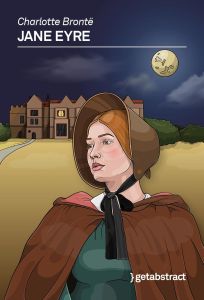
Jane Eyre
- Novel
- Victorian literature
What It’s About
An Uncompromising Woman
The story of Jane Eyre may read like a Cinderella fairytale, but it’s far from one: A destitute orphan and governess falls in love with her rich employer and, having overcome many adverse circumstances through virtue, marries him in the end. But the tale of this unusual woman in 19th century England – a period of outlandish prudishness and a rigorous social order – is no penny dreadful. Despite her dismal prospects, Jane Eyre is neither a pliant housewife nor a racy mistress, but a strong, independent woman. She fights for her respect, freedom and integrity, even at the cost of immense personal sacrifice. Some twists of events appear unlikely, others absurd, and as a result there are times when Charlotte Brontë’s novel threatens to drift into triviality. But thanks to her spirited and deep characterizations, the author manages to keep her readers hooked to the end. At the time of its publication, Jane Eyre was a blockbuster success. It continues to be one of the most widely read classics of English literature.
Summary
About the Author
Charlotte Brontë was born on April 21, 1816, in Thornton/Yorkshire and grew up in the inhospitable North England moorlands as the daughter of a clergyman of Irish decent. Her mother, Maria, died early, as did two of her older sisters, who contracted tuberculosis while at boarding school. Charlotte’s father, Patrick, took her out of boarding school to home school her and her three other siblings. Together with her younger sisters Emily and Anne and the brother Branwell, Charlotte invented a rich fantasy world, which was immortalized in their diaries. Patrick unfailingly supported his children in their intellectual curiosity. In 1831, Charlotte once again attended a boarding school, where she studied to become a teacher. Starting in 1839, began work as a governess. In 1842, she travelled to Brussels with her sister Emily. With the prospect of opening their own school, Charlotte dedicated herself to learning German and fell into an unrequited love with her married teacher Constantin Heger. Feeling terribly homesick, she returned to England in 1844. After the plan to open their own school went nowhere, Charlotte and her sisters published a collection of poems at their own expense, and under the pseudonyms Currer (Charlotte), Ellis (Emily) and Acton (Anne), gender neutral names that they deliberately chose to evade prejudices against female writers. The volume sold no more than two copies, yet the sisters refused to give up, all of them publishing their first novels in 1847: Wuthering Heights by Emily, Agnes Grey by Anne and Jane Eyre by Charlotte, the last to great public acclaim. Unfortunately, the sisters could not enjoy their newfound success for long: In September 1848, Branwell died, three months later Emily and in May 1849 Anne. That same year Charlotte’s second book Shirley was published, and four years later came her novel Villette. After the success of her novels, Charlotte met many famous writers, including William Makepeace Thackeray and Elizabeth Gaskell. In 1854, she married Arthur Bell Nicholls, a curate. Nine months later after the wedding, on March 31, 1855, she died. Her death came just three weeks before her 39th birthday; she was pregnant.










Comment on this summary or Start Discussion